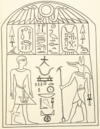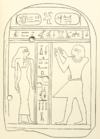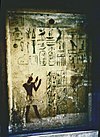Abydos Dynasty
Abydos Dynasty | |||||||||||
|---|---|---|---|---|---|---|---|---|---|---|---|
| c. 1650 BC–c. 1600 BC | |||||||||||
|
Map of Egypt during the Fifteenth, Abydos, and Sixteenth Dynasties | |||||||||||
| Capital | Abydos | ||||||||||
| Common languages | Egyptian language | ||||||||||
| Religion | Ancient Egyptian religion | ||||||||||
| Government | Absolute monarchy | ||||||||||
| Historical era | Bronze Age | ||||||||||
• Established | c. 1650 BC | ||||||||||
• Disestablished | c. 1600 BC | ||||||||||
| |||||||||||
| Periods and dynasties of ancient Egypt |
|---|
|
All years are BC |
The Abydos Dynasty is hypothesized to have been a short-lived local dynasty ruling over parts of Middle and Upper Egypt during the Second Intermediate Period in Ancient Egypt. The Abydos Dynasty would have been contemporaneous with the Fifteenth and Sixteenth Dynasties, from approximately 1650 to 1600 BC.[1] It would have been based in or around Abydos and its royal necropolis might have been located at the foot of the Mountain of Anubis, a hill resembling a pyramid in the Abydene desert, close to a rock-cut tomb built for pharaoh Senusret III.
Debate over existence
[edit]Evidence in favor
[edit]
The existence of an Abydos Dynasty was first proposed by Detlef Franke[2] and later elaborated on by Kim Ryholt in 1997. Ryholt observes that two attested kings of this period, Wepwawetemsaf (Wepwawet is his protection) and Pantjeny (He of Thinis), bore names in connection with Abydos: Wepwawet being an important Abydene god and Thinis being a prominent city, located a few miles north of Abydos. Additionally, Wepwawetemsaf, Pantjeny and Snaaib, another king of the period, are each known from single stelae discovered in Abydos, which could be a sign that this was their seat of power.[3] Finally, Ryholt argues that the existence of an Abydos Dynasty would explain 16 entries of the Turin canon at the end of the 16th Dynasty. The Abydos Dynasty may have come into existence in the time lapse between the fall of the 13th Dynasty with the conquest of Memphis by the Hyksos and the southward progression of the Hyksos to Thebes.[3]
The existence of the dynasty may have been vindicated in January 2014, when the tomb of the previously unknown pharaoh Senebkay was discovered in the southern part of Abydos, an area called "Anubis Mountain" in ancient times. If Senebkay indeed belongs to the Abydos Dynasty, his tomb might signal the royal necropolis of this dynasty, adjacent to the tombs of the Middle Kingdom rulers.[1] Since then, excavations have revealed no less than eight anonymous royal tombs dating to the Second Intermediate Period similar in style and size to Senebkay's burial, as well as two tombs, possibly pyramids, dating to the mid 13th-Dynasty, S9 and S10, which may belong to Neferhotep I and his brother Sobekhotep IV.[4]
Evidence against
[edit]The existence of an Abydos Dynasty is not agreed by all scholars. For example, Marcel Marėe observes that a workshop operating from Abydos and producing stelae for two kings associated with the Abydos Dynasty, Pantjeny and Wepwawetemsaf, also likely produced the stela of Rahotep of the 17th Dynasty. Thus if the Abydos Dynasty did exist, this workshop would have been producing stelae for two enemy dynasties, something which he judges to be rather unlikely.[5] It remains unclear, however, whether these two dynasties coexisted at any one time: for instance, in Ryholt's reconstruction of the Second Intermediate Period, they are separated by c. 20 years.[3]
Countering the argument in favor of the Abydos Dynasty based on the tomb of Senebkay, Alexander Ilin-Tomich argues that certain Middle Kingdom pharaohs, such as Senusret III and Sobekhotep IV, also have their tombs at Abydos, yet nobody places these kings into an Abydos-based dynasty. At the opposite, he wonders whether Senebkay might be a king of the Theban 16th Dynasty.[6]
Territory
[edit]
If the Abydos Dynasty was indeed a dynasty, the seat of its power would probably have been either Abydos or Thinis. A possible graffito of Wepwawetemsaf was discovered by Karl Richard Lepsius in the tomb BH2 of the 12th Dynasty nomarch Amenemhat at Beni Hasan, about 250 km North of Abydos, in Middle Egypt. If the attribution of this graffito is correct and if Wepwawetemsaf did belong to the Abydos Dynasty, then its territory might have extended that far north.[3] Since the dynasty was contemporaneous with the 16th Dynasty, the territory under Abydene control could not have extended farther than Hu, 50 km south of Abydos.[3]
Rulers
[edit]The following 16 entries of the Turin canon are attributed to the Abydos Dynasty by Kim Ryholt:[3]
| Prenomen of the King | Entry of the Turin canon | Transliteration |
|---|---|---|
| Woser[...]re | Col 11. Line 16 | Wsr-[...]-Rˁ |
| Woser[...]re | Col 11. Line 17 | Wsr-[...]-Rˁ |
| Eight kings lost | Col 11. Lines 18-25 | |
| [...]hebre | Col 11. Line 26 | [...]-hb-[Rˁ] |
| Three kings lost | Col 11. Lines 27-29 | |
| [...]hebre (uncertain) | Col 11. Line 30 | [...]-ḥb-[Rˁ] |
| [...]webenre | Col 11. Line 31 | [...]-wbn-[Rˁ] |
Some of the above rulers may identify with the four attested kings tentatively attributable to the Abydos Dynasty, given here without regard for their (unknown) chronological order:
| Name of king | Image | Comment |
|---|---|---|
| Sekhemraneferkhau Wepwawetemsaf |  |
May belong to the late 16th Dynasty[5] |
| Sekhemrekhutawy Pantjeny |  |
May belong to the late 16th Dynasty[5] |
| Menkhaure Snaaib |  |
May belong to the late 13th Dynasty[7][8][9] |
| Woseribre Senebkay |  |
Perhaps identifiable with a Woser[...]re of the Turin canon |
| Khuiqer |  |
Uncertain date and period of reign, attributed by Detlef Franke to the Abydos Dynasty[10] |
Notes
[edit]References
[edit]- ^ a b "Giant Sarcophagus Leads Penn Museum Team in Egypt To the Tomb of a Previously Unknown Pharaoh". Penn Museum. January 2014. Retrieved 16 Jan 2014.
- ^ Detlef Franke: Zur Chronologie des Mittleren Reiches. Teil II: Die sogenannte Zweite Zwischenzeit Altägyptens, In Orientalia 57 (1988), p. 259
- ^ a b c d e f Ryholt, K.S.B. (1997). The Political Situation in Egypt During the Second Intermediate Period, C. 1800-1550 B.C. Museum Tusculanum Press. p. 164. ISBN 8772894210.
- ^ Josef W., Wegner (2015). "A royal necropolis at south Abydos: New Light on Egypt's Second Intermediate Period". Near Eastern Archaeology. 78 (2): 68–78. doi:10.5615/neareastarch.78.2.0068. S2CID 163519900.
- ^ a b c Marcel Marée: A sculpture workshop at Abydos from the late Sixteenth or early Seventeenth Dynasty, in: Marcel Marée (editor): The Second Intermediate period (Thirteenth-Seventeenth Dynasties), Current Research, Future Prospects, Leuven, Paris, Walpole, MA. 2010 ISBN 978-90-429-2228-0. p. 247, 268
- ^ Alexander Ilin-Tomich: The Theban Kingdom of Dynasty 16: Its Rise, Administration and Politics, in: Journal of Egyptian History 7 (2014), 146; Ilin-Tomich, Alexander, 2016, Second Intermediate Period. In Wolfram Grajetzki and Willeke Wendrich (eds.), UCLA Encyclopedia of Egyptology, Los Angeles. http://digital2.library.ucla.edu/viewItem.do?ark=21198/zz002k7jm9 p. 9-10
- ^ Jürgen von Beckerath: Untersuchungen zur politischen Geschichte der Zweiten Zwischenzeit in Ägypten, Glückstadt, 1964
- ^ Jürgen von Beckerath: Chronologie des pharaonischen Ägyptens, Münchner Ägyptologische Studien 46. Mainz am Rhein, 1997
- ^ Jürgen von Beckerath: Handbuch der ägyptischen Königsnamen, Münchner ägyptologische Studien 49, Mainz 1999.
- ^ Schneider, T. (2009). "Das Ende der kurzen Chronologie: Eine kritische Bilanz der Debatte zur absoluten Datierung des Mittleren Reiches und der Zweiten Zwischenzeit". Ägypten und Levante. 18: 275–314. doi:10.1553/aeundl18s275. ISSN 1015-5104.
Sources
[edit]- Reid, Donald Malcolm (2003). Whose Pharaohs? Archaeology, Museums, and Egyptian National Identity from Napoleon to World War I. University of California Press. ISBN 9780520240698.
- Abydos Dynasty
- States and territories established in the 17th century BC
- States and territories disestablished in the 16th century BC
- Dynasties of ancient Egypt
- Abydos, Egypt
- 17th century BC in Egypt
- Pharaohs of the Abydos Dynasty
- Fifteenth Dynasty of Egypt
- Sixteenth Dynasty of Egypt
- 17th-century BC establishments in Egypt
- 2nd-millennium BC disestablishments in Egypt
- 2nd millennium BC in Egypt

